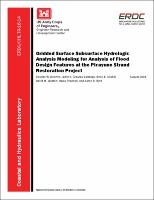Please use this identifier to cite or link to this item:
https://hdl.handle.net/11681/20298| Title: | Gridded surface subsurface hydrologic analysis modeling for analysis of flood design features at the Picayune Strand Restoration Project |
| Authors: | Downer, Charles Wayne Skahill, Brian E. (Brian Edward) Pradhan, Nawa Raj Byrd, Aaron R. Graulau-Santiago, Jaime A. Weston, David M. |
| Keywords: | Floods Flood control Hydrologic models Computer simulation |
| Publisher: | Coastal and Hydraulics Laboratory (U.S.) Engineer Research and Development Center (U.S.) |
| Series/Report no.: | Technical Report (Engineer Research and Development Center (U.S.)) ; no. ERDC/CHL TR-16-14 |
| Abstract: | The Picayune Strand Restoration Project is one of many components of the Comprehensive Everglades Restoration Project (CERP) intended to restore nearly 700 hectares of a failed residential development in southwestern Collier County, FL, to its predevelopment wetland conditions. A detailed analysis was performed to derive a restoration plan that will achieve this goal. As required by the Water Resources Development Act (WRDA) 2000, the U.S. Army Corps of Engineers (USACE) is required to ensure that no component of CERP results in an effective taking of land by adversely impacting the level of flood protection of adjacent landowners. To ensure the current level of flood protection is maintained, a hydrologic model was developed to assess the potential for flooding and to refine the proposed flood mitigation features. The USACE physically based Gridded Surface Subsurface Hydrologic Analysis (GSSHA) model was selected for this effort. The GSSHA model simulates fully coupled rainfall distribution, extraction, retention, overland flow, and one-dimensional channel flow. Models of varying resolution were developed from existing and proposed design data and were initially populated with parameter values from a previous hydrodynamic modeling effort. Parameters were then tuned to observed stage and flow data using the Secant Levenberg-Marquardt method, a nonlinear least squares minimization computer-based local search method. The calibrated model is capable of reproducing canal flows, canal stages, and overland stages with very high Nash Sutcliffe Forecast Efficiencies, generally 0.9 or higher. Subsequent uncertainty analysis allowed water stages to be estimated with 95% certainty. Modeling and uncertainty analysis results allowed for refinement of the proposed flood mitigation features. The hydrologic models and analysis demonstrated that some of the features in the original plan were either unnecessary or overdesigned and could be modified or eliminated, resulting in $40M in flood control feature construction cost savings. |
| Description: | Technical Report |
| Gov't Doc #: | ERDC/CHL TR-16-14 |
| Rights: | Approved for Public Release; Distribution is Unlimited |
| URI: | http://hdl.handle.net/11681/20298 |
| Appears in Collections: | Technical Report |
Files in This Item:
| File | Description | Size | Format | |
|---|---|---|---|---|
| ERDC-CHL TR-16-14.pdf | 14.61 MB | Adobe PDF |  View/Open |